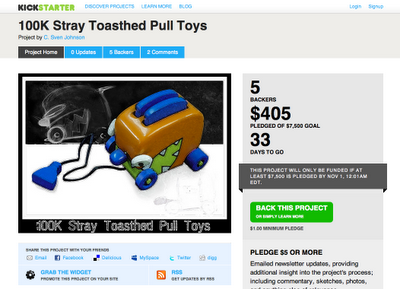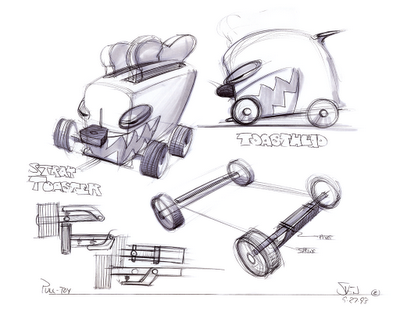If you’re a follower of design technology then chances are you’ve come across C Sven Johnson, former blogger on Core77.com and author of the ReBang blog. I noticed that he’d been talking about a KickStarter project during a recent twitter stream and took a look, finding the results fascinating. When we’re facing a constriction of design freedom, due to economic pressures, with those that hold the purse strings clinging onto them for dear life, one option, particularly for the independents, is to go it alone. Develop a product, take it to manufacture and sale. But of course, that takes one thing that’s rarely in abundance – cash.
This is where something like KickStarter comes in. You get an idea, you detail it and you hope that the community stumps up the cash to help you out. It’s not crowdsourcing in terms of creativity (I’ll save you the usual drivel about threadless et al), but it certainly is crowdsourcing of funding. So, I caught up with C Sven and asked him to give us the background on the project, where it came from and what he’s working on.
The development idea for 100K Stray Toastheds is itself the product of a few years of conceptual gestation. Back in early 2006, before Fabjectory, Ponoko, Figureprints and other fabbing-centric sites popped up, Pete Cashmore, Mashable’s founder, contacted me. He’d come across my blog (via Wired’s Chris Anderson’s “Long Tail” blog entry on my 3D ripping example) and asked if I was interested in setting up a 3D printing service fabbing avatars (I wanted to fab jewelery). As it turned out, what we were chasing was very much what Ponoko has done with 100KGarages; only geared towards service bureaus instead of home-based CNC users. Unfortunately we ran into a few snags, including a general lack of interest from the service bureaus who, for the most part, didn’t grok what we were doing or how it might benefit them.
Mashable, of course, began to take off quickly around that time and I was starting work on MTV’s first 3D virtual world project, so our informal partnership fizzled. However, the idea stuck with me, and towards the end of the year, as my contract on the MTV gig was nearing completion, I realized that the only way around the reluctant service bureaus was, eventually, to go to the people using their own 3D printers. With that in mind, I backed out of my virtual world development consulting and shifted back to regular product development; I didn’t want to get too far away from tangible goods.
Continuing to look for ways to set up a decent service, I determined that the biggest hindrance to acceptance by the product development community was the potential for 3D file “sharing”. A thread on CGTalk had stuck with me over the years and I kept imagining how most industrial designers would react. So for a long while I spent a lot of time watching the music industry, the problems cropping up on Flickr and in Second Life and around Facebook, and trying to wrap my head around reputation systems and intellectual property.
AdvertisementAdvertisement
About a year ago or so I realized what was needed for an online distributed system to work; not just for 3D files but for most if not all content. Lacking that application, one of the first things I did when 100KGarages was announced was see how it handled file “sharing”. It doesn’t. It’s going on the honor system, as far as I can tell.
In the meantime, Jerry Paffendorf, a friend of mine from my early 3D ripping exploration/Second Life/MTV virtual world days had gotten into the Kickstarter beta and phoned me to brainstorm some ideas for a project he was considering. I was curious about Kickstarter, but initially underwhelmed. Kickstarter, for me, is an idea that probably a lot of people have but no one ever actually thinks could work, so they dismiss it without a second thought. The brilliance isn’t the idea; it’s in not dismissing the idea. As Jerry launched, met his first funding goal and then proceeded into a second round, I took notice. Other projects were getting funding as well; including some which really didn’t seem like something I’d expect would be funded. I kept wondering, “Where are the humanitarian projects, like …”? And then finally it hit me.
My first stab at a project was to make a product for developing countries. It was with that project in mind that I approached Jerry asking to be put in touch with Kickstarter’s founders so I could launch that product development project. On Jerry’s recommendation, they contacted me. They didn’t know the details of the project I was wanting to pursue, but I was invited to join.
However, after a couple of weeks of initial research into my humanitarian product idea, I ran into a bit of reality: the likelihood that the problem I was hoping to address wasn’t a product issue but a cultural issue.
Putting that idea on slow burn, I decided to look for something less ambitious to simply test the concept of going to the community for product development funding. And that’s when Ponoko launched 100KGarages. I immediately knew what I wanted to do, and fortunately I found a perfect candidate product.
The Toasthed Pull Toy was originally a school project; one I didn’t want to do because we’d already done toys and I wanted to do a medical product or something similarly sophisticated. I did three pages of sketches; the first filled with a variety of pull toy forms, picked this one, and did a couple more rough sketch pages to figure out how it might work. From there I banged out a foam model.
For me, it was a quick, class-required effort; not something of which I was especially proud. Surprisingly, it got an excellent response. If it hadn’t, I’d probably not have bothered photographing the model.
As it turns out, however, because the Toasthed toy was left so unresolved yet so seemingly finished, it makes an excellent test case for Kickstarter. Because there’s a decent model, people are more apt to believe in the project’s chances for success. If it’s nothing more than what they see, that may be good enough.
My intentions, however, are to revisit the design with both a better attitude and 16 years of experience under my belt. I now see this toy becoming a kind of platform for customization (as indicated by my reference to Build-a-Bear on the project page). That opens up some interesting possibilities; not just in the product but in how the community grows the product on its own.
We’ll see how it goes. While the design is of renewed interest to me, it’s the circumstances surrounding this project which are of greater interest. I don’t know of any other product being “crowdfunded” in this way. And if I get funded and can set a good example, it opens the door to other industrial designers with good ideas and not enough funds to make them a reality. Given the state of the economy, Kickstarter and its eventual imitators may provide a springboard to something pretty interesting. That’s what this project is really about, as far as I’m concerned.
I find this fascinating. The idea that it might be possible to take a product at least to a pre-release manufacturing state, share both the intellectual property and any rewards, without formalised backing. That’s an indication of a shift. Crowdsourcing is a phrase often bandied around as is Community, when dealing with online activities. If you look at an example where the two work together very successfully, look at threadless and the many other t-shirt community sites out there. They source graphic design work from their community, find which designs are popular, then print those up – and sell them – and in some cases, sell a LOT of them. The designer gets a decent fee, no set-up costs and fame and glory. The company makes a crap lot of cash – by using the community to reduce the risk of failure of a product, by having a self filtering system for its products. But that’s just t-shirts.
C Sven is talking about hard products, products which are ‘more likely’ to be involved in legal and liability action, should faults occur (after all, you’d have to be pretty unlucky to choke on a t-shirt). The legal problems are discussed in the comments on the project page. We were so taken with this that we chipped in a few quid but he’s still got a way to go, if you’re interested, then the project page is here and all donations are, I’m sure welcome. Whether this project gets the green light or not, as he says, doesn’t really matter. What I find most interesting is that this sort of thing is possible at all. It’s certainly not going to replace how things are done for the 99.9% of us, but for those with a good solid idea, it’s another avenue to explore and see where you can go.








